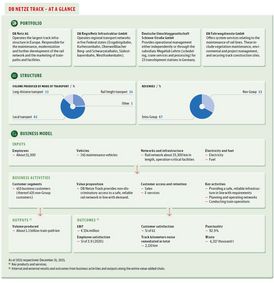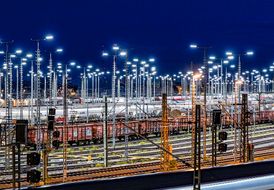DB Netze Track business unit
Business model
With more than 33,000 km of track, DB Netze Track operates the largest rail network in Europe. More than one billion train-path kilometers are traveled each year on the tracks in Germany. The most important sources of income are revenues from train-path products, which constitute over 90% of total revenues. Train-path prices are established on a transparent basis by a train-path pricing system regulated by the BNetzA.
DB Netze Track is also responsible for managing infrastructure operations as well as for securing long-term infrastructure quality and availability, and non-discriminatory access to train-paths and service facilities. This includes preparing schedules in close cooperation with customers, operations management, construction management and maintenance.

The cost structure has a high proportion of fixed costs. The rail network in particular is one of the biggest cost drivers. The use of resources for the operation and maintenance of infrastructure facilities is very much influenced by specific facility characteristics, requirements relating to operational opening hours and the degree of rationalization in operating business activities. As the dimensions of the infrastructure only change in the long term due to new construction or expansion projects or targeted dismantling, the optimal capacity utilization of the existing infrastructure is of major importance for economic success.
A high level of quality and availability for customers also calls for a forward-looking integrated capital expenditure and predictive maintenance strategy. Capacity utilization is measured by train kilometers on track infrastructure. In terms of relative network capacity utilization, this figure can be compared to track kilometers. To reach our transport growth target of an increase of more than 30% in train-path kilometers, it is essential that new construction and expansion/upgrade projects concentrate on removing bottlenecks and on the creation of additional capacity for growth in transport in the main corridors and metropolitan areas.
A forecast of demand for 2040 is made as part of the Network Concept 2040 (Netzkonzeption 2040) project. The demand forecast shows that growth will be concentrated in the main corridors and metropolitan areas. Now that the third expert draft on Germany in sync and the necessary infrastructure measures have been published, the Germany in sync target schedule can also be taken into account when assessing expansion requirements. On this basis, the Network Concept devises a bottleneck-free target network for 2040. An implementation concept will then be developed to optimize the timing of the infrastructure expansion required to achieve the target network, factoring in coordination with the sector on the timing of the phases of Germany in sync.
The contributions made by the Federal Government to the infrastructure financing are of material importance to secure the competitiveness of rail as a mode of transport. The budgetary resources of public authorities, in particular the Federal Government, are of considerable relevance for the financing of replacement capital expenditures in the existing infrastructure, as well as for the financing of new construction and expansion/upgrade projects. In order to implement Germany in sync, there is a need for extensive infrastructure expansion that goes significantly beyond the previous Federal Transport Infrastructure Plan. In addition, in order to implement the target schedule for Germany in sync, it is also assumed that a large number of local transport projects will be implemented by the Federal states. DB Netz AG therefore assumes that a significant increase in annual funds for infrastructure expansion will need to be provided by the Federal Government, the Federal States and DB Group.



